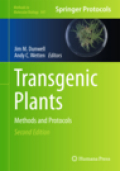
In 2010 the global area of transgenic crops reached 148 million hectares, an 87-fold increase since 1996, making it the most rapidly adopted technology in the history of modern agriculture. In Transgenic Plants: Methods and Protocols, Second Edition expert researchers in the field provide key techniques to investigate production and analysis of transgenic plants. Focusing on selection and detection methods, transformation technology, gene targeting, silencing and directed mutation, metabolic engineering and pharming, the book encompasses protocols relating to major crops and model plants being used for genomic analysis. Written in the highly successful Methods in Molecular Biology ™ series format, the chapters include the kind of detailed description and implementation advice that is crucial for getting optimal results in the laboratory. . Thorough and intuitive, Transgenic Plants: Methods and Protocols, Second Edition aids scientists in the continuous improvements being made for the production and analysis of transgenic plants. Provides access to the most up-to-date improvements being made for the production and analysis of transgenic plants. Provides step-by-step detail essential for reproducible results. Contains key notes and implementation advice from the experts. INDICE: Employment of Cytokinin Vectors for Marker-Free and Backbone-Free Transformation.-Organophosphorus Hydrolase; a Multifaceted Plant Genetic Marker Which is Selectable, Scorable, and Quantifiable in Whole Seed.-Use of Northern Blotting for Specific Detection of Small RNA Molecules in Transgenic Plants.-Genetic Transformation of the Model Green Alga Chlamydomonas reinhardtii. A High Efficiency Agrobacterium -mediated Transformation System of Rice ( Oryza sativa L. ).-Selection of Transgenic Rice Plants Using a Herbicide Tolerant Form of the Acetolactate Synthase Gene.-Visual Selection in Rice—a Strategy for the Efficient Identification of Transgenic Calli Accumulating Transgene Products.-Characterization of Rice Genes using Heterologous a Full-length cDNA Expression System.-Bioactive Bead-mediated Transformation of Plants with Large DNA Fragments. Agrobacterium -mediated Transformation of Sorghum bicolor Using Immature Embryos.-Split-transgene Expression in Wheat.-Agrobacterium-mediated Transformation of Brachypodium Distachyon.-Transformation of Barley ( Hordeum vulgare L.) by Agrobacterium tumefaciens Infection of In Vitro Cultured Ovules.-Biolistic Mediated Production of Transgenic Oil Palm.-Transformation of Oil Palm using Agrobacterium tumefaciens. Highly Efficient Transformation Protocol for Plum ( Prunus domestica L.).-Co-transformation of Grapevine Somatic Embryosto Produce Transgenic Plants Free of Marker Genes.-Initiation and Transformation of Grapevine Embryogenic Cultures.-Development of Highly Efficient GeneticTransformation Protocols for Table Grape Sugraone and Crimson Seedless.-Cotton Pistil Drip Transformation Method.-Enhanced Agrobacterium -mediated Transformation of Embryogenic Calli of Upland Cotton.-Targeted Biolistics for ImprovedTransformation of Impatiens balsamina. A Protocol for Transformation of Torenia.-Efficient Modification of Floral Traits by Heavy-Ion Beam Irradiation on Transgenic Torenia.-High Frequency of Single-copy T-DNA Transformants Producedafter Floral Dip in CRE -expressing Arabidopsis Plants.-A Developmentally Regulated Cre- lox system to Generate Marker-free Transgenic Brassica napus Plants.-Exploiting Multisite Gateway and pENFRUIT Plasmid Collection for Fruit Genetic Engineering.-A One-time Inducible Transposon to Create Knockout Mutants inRice.-Marker-free Gene Targeting by Recombinase-mediated Cassette Exchange (RMCE).-Targeting DNA to a Previously Integrated Transgenic Locus Using Zinc Finger Nucleases.-Double-strand Break-induced Targeted Mutagenesis in Plants.-Combinatorial Genetic Transformation of Cereals and the Creation of Metabolic Libraries for the Carotenoid Pathway.-Production of a His-Tagged Canecystatin in Transgenic Sugarcane.-Plastid Transformation as an Expression Tool for Plant-Derived Biopharmaceuticals.-Use of a Callus-Specific Selection System to Development Transgenic Rice Seed Accumulating a High Level of Recombinant Protein.-How to Grow Transgenic Arabidopsis
- ISBN: 978-1-61779-557-2
- Editorial: Humana Press
- Encuadernacion: Cartoné
- Páginas: 574
- Fecha Publicación: 28/03/2012
- Nº Volúmenes: 1
- Idioma: Inglés
